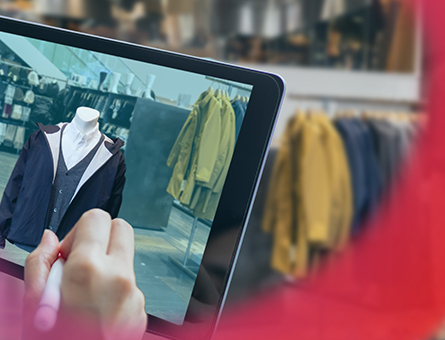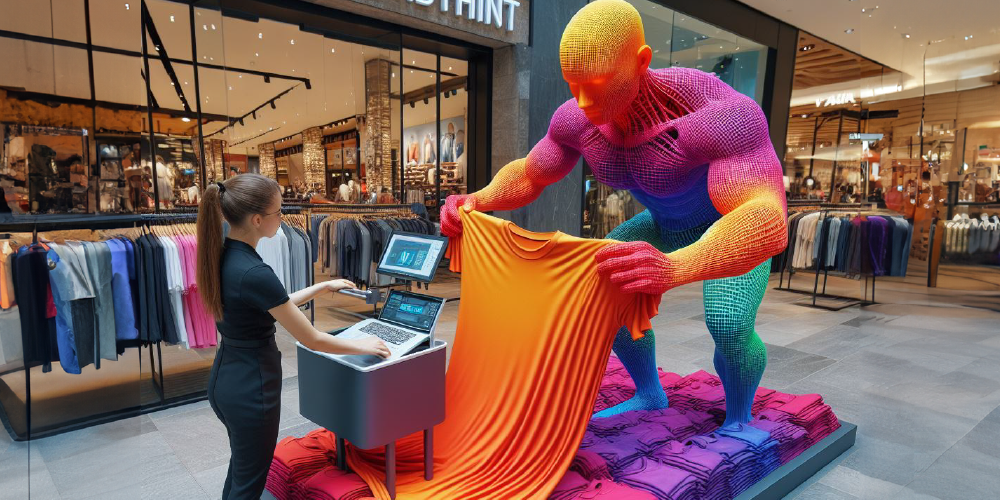In the ever-evolving world of fashion, where trends shift as quickly as the seasons, one constant remains: change. However, the change we’re witnessing today isn’t just about shifting tastes or hemlines—it’s a seismic transformation driven by technology. From AI-driven design to sustainable practices, the apparel landscape is being reshaped by data, innovation, and a commitment to a more personalized and eco-conscious future. In this article, we’ll dive deep into the key trends shaping the industry and provide actionable insights for retailers and brands looking to not just keep up but lead the charge into the fashion future.
Riding the AI Wave:
The emergence of artificial intelligence (AI) has revolutionized how fashion is conceived, created, and consumed. No longer confined to the realm of science fiction, AI algorithms are now integral to every aspect of the fashion supply chain. Take, for example, a shoe brand that has leveraged AI to personalize shoe recommendations based on individual running data and preferences, creating a truly unique shopping experience. Here are some common uses of AI in the fashion industry:
Smart Design & Manufacturing: AI algorithms are analyzing customer data to predict trends, optimize designs, and even generate personalized clothing patterns. Imagine AI-powered robots seamlessly stitching garments based on individual measurements!
Virtual Try-On & Styling: Forget changing rooms, AI-powered virtual mirrors are letting you try on clothes in augmented reality, complete with personalized styling suggestions.
Chatbots & Voice Assistants: Say goodbye to endless browsing. Chatbots and voice assistants are making shopping a breeze, answering questions, recommending products, and even helping with returns.
Data is the New Fabric:
In today’s data-driven world, information is as essential to fashion as fabric. Retailers are harnessing the power of big data to gain valuable insights like:
Customer Insights: Retailers are analyzing mountains of customer data to understand preferences, predict behavior, and personalize marketing campaigns.
Demand Forecasting: Gone are the days of overstocking or stockouts. Advanced analytics are predicting demand with pinpoint accuracy, optimizing inventory management and reducing waste.
Dynamic Pricing: Prices are no longer static. Dynamic pricing algorithms are adjusting prices based on demand, competitor analysis, and even individual customer behavior.
Personalization is the New Black:
In an era of mass production and fast fashion, consumers are craving authenticity and individuality. Brands that embrace personalization are not only meeting this demand but setting themselves apart in a crowded market. Take notes on some important trends that are a fundamental shift in the way fashion is consumed and experienced:
Customization: Say hello to “you-nique” fashion! Brands are offering customization options, from personalized embroidery to custom-printed fabrics.
Subscription Services: Clothing rental services are booming, offering access to a curated wardrobe without the commitment of buying.
Connected Clothing: Imagine clothes that track your fitness or adjust to your mood? Smart fabrics integrated with sensors are pushing the boundaries of personalization.
Sustainability Takes Center Stage:
With growing concerns about the environmental impact of fast fashion, sustainability has become a top priority for consumers and brands alike. These efforts are not only good for the planet but also good for business, as consumers increasingly vote with their wallets in favor of brands that align with their values.
Eco-Friendly Materials: Brands are embracing sustainable materials like organic cotton, recycled polyester, and even algae-based fabrics.
Circular Fashion: The “buy-use-dispose” model is out. Circular fashion promotes garment longevity through repair, upcycling, and resale platforms.
Transparency & Traceability: Consumers are demanding transparency in supply chains. Blockchain technology is tracking the journey of garments, ensuring ethical and sustainable practices.
Leading the Fashion Charge: Real-World Examples:
The fashion industry is brimming with innovative players embracing the trends mentioned earlier. By learning from their successes and failures, retailers and brands can gain valuable insights into how to navigate the complex and ever-changing fashion landscape. Let’s delve into some inspiring examples:
AI & Data-Driven Powerhouses:
Nike: Utilizes AI to personalize shoe recommendations based on individual running data and preferences, creating a truly unique shopping experience.
Zara: Leverages advanced analytics to optimize inventory management, ensuring popular styles are always available and reducing waste.
Zalando: Employs AI-powered styling algorithms to generate personalized outfit recommendations for each customer, boosting conversion rates.
Personalization Champions:
Mass Customization: Levi’s offers custom embroidery on jeans and jackets, allowing customers to express their individuality.
Subscription Services: Rent the Runway provides access to designer clothing through a subscription model, catering to the desire for variety and sustainability.
Stitch Fix: Curates personalized clothing boxes based on individual style preferences and fit, offering a convenient and personalized shopping experience.
Sustainable Pioneers:
Patagonia: Champions responsible sourcing and uses recycled materials in many of its garments, leading the way in sustainable fashion practices.
The North Face: Offers a take-back program for used gear, repairing and reselling items to extend their life cycle and reduce waste.
Stella McCartney: Embraces sustainable materials like vegan leather and organic cotton, demonstrating a commitment to eco-friendly fashion.
Tech-Savvy Innovators:
Gucci: Launched a virtual store experience powered by AR, allowing customers to try on clothes virtually from anywhere in the world.
Sephora: Utilizes AI-powered skin analysis tools to recommend personalized beauty products in-store, enhancing the customer experience.
Warby Parker: Offers a virtual try-on feature for its glasses, making online shopping for eyewear more convenient and accurate.
Actionable Steps for Retailers & Brands to Adapt to Fashion’s Tech Wave:
To succeed in the tech-infused future of fashion, retailers and brands must embrace AI-driven strategies, prioritize personalization, and commit to sustainable practices. This requires investing in talent, developing robust data infrastructure, and experimenting with new technologies. By doing so, fashion businesses can create a more personalized, efficient, and responsible future for the industry.
AI & Data-Driven Strategies:
Implement AI-powered design tools: Partner with companies offering AI-driven design platforms to optimize patterns, predict trends, and even generate personalized designs based on customer data.
Develop virtual try-on experiences: Invest in AR/VR technology to allow customers to virtually try on clothes in-store or online, increasing engagement and conversion rates.
Utilize chatbots & voice assistants: Integrate chatbots on your website and social media to answer customer questions, recommend products, and handle simple tasks, freeing up human staff for more complex interactions.
Leverage customer data: Analyze customer data to personalize marketing campaigns, product recommendations, and even pricing strategies.
Invest in demand forecasting tools: Implement AI-powered demand forecasting solutions to optimize inventory management, reduce waste, and ensure product availability.
Personalization & Customization:
Offer customization options: Allow customers to personalize garments with embroidery, prints, or unique touches to create a “you-nique” experience.
Develop subscription services: Consider offering clothing rental or subscription boxes curated based on individual preferences and style profiles.
Partner with on-demand manufacturing platforms: Collaborate with companies offering on-demand garment production to create limited-edition or personalized pieces based on customer demand.
Explore connected clothing technologies: Research and pilot the use of smart fabrics integrated with sensors for personalized experiences like fitness tracking or mood-responsive wearables.
Sustainability & Transparency:
Source eco-friendly materials: Partner with suppliers offering organic cotton, recycled materials, and other sustainable fabric options.
Implement circular fashion initiatives: Develop programs for garment repair, upcycling, and resale to extend the life of clothing and reduce waste.
Embrace transparency in your supply chain: Utilize blockchain technology or other tools to track the journey of your garments, ensuring ethical and sustainable practices.
Communicate your sustainability efforts: Share your commitment to sustainability with your customers through marketing campaigns and transparent reporting.
Building Your Tech & Analytics Infrastructure:
Invest in talent: Recruit data scientists, AI specialists, and marketing analysts with expertise in the fashion industry.
Develop a data platform: Choose a cloud-based solution or build a robust data infrastructure to collect, store, and analyze customer data effectively.
Experiment with new technologies: Allocate resources to pilot innovative technologies like AI, VR, and AR to identify opportunities for differentiation.
Partner with tech companies & startups: Collaborate with specialized tech players to access cutting-edge solutions and expertise.
The fashion industry is undergoing a fascinating transformation. By embracing technology, data, and sustainability, brands and retailers can create a more personalized, efficient, and responsible future for fashion. So, fasten your seatbelts, and get ready for a wild ride on the ever-evolving fashion wave!






